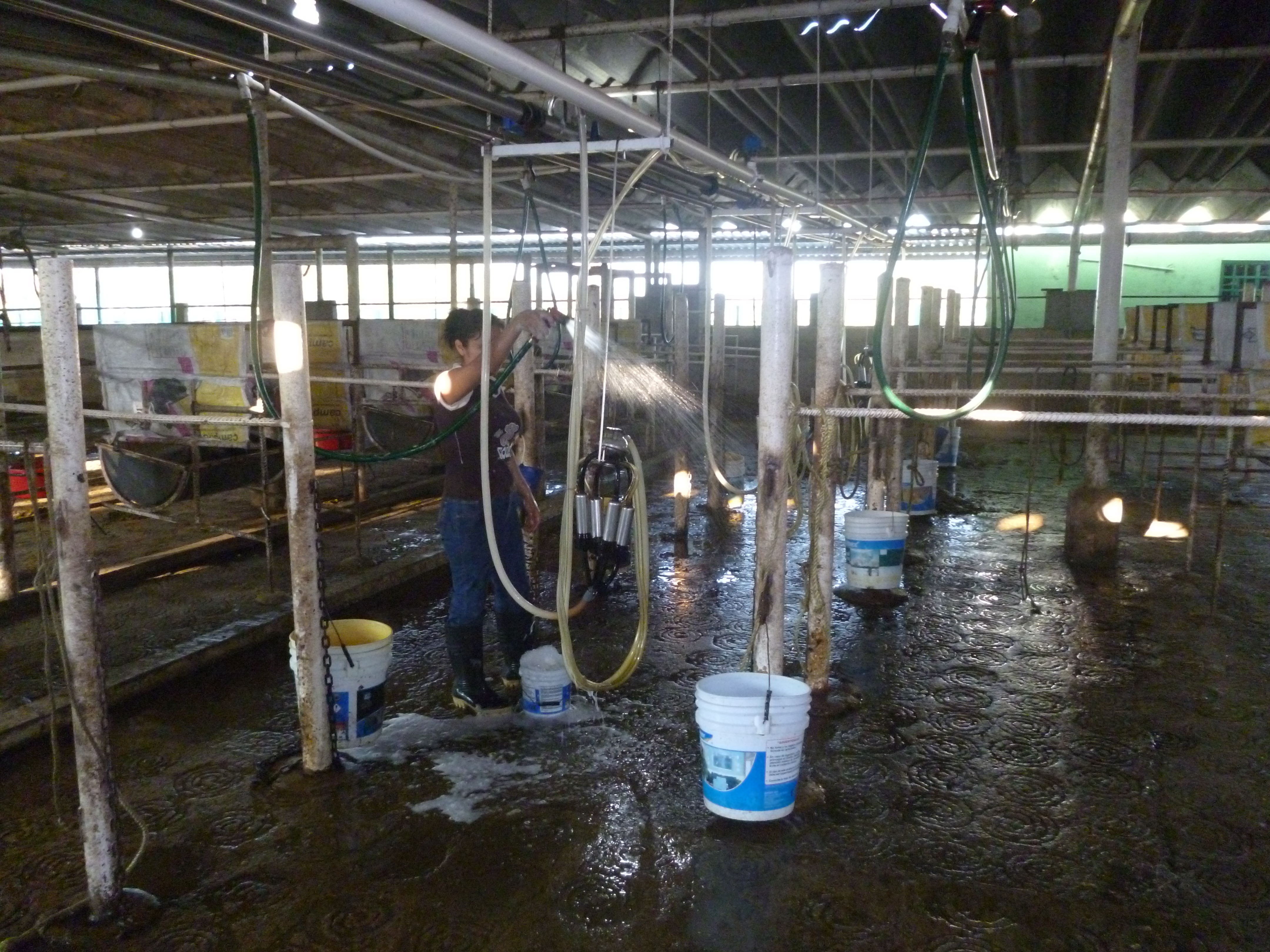Comparative study of the hygienic-sanitary, physicochemical, and microbiological quality of bovine milk in southeastern Mexico
Estudio comparativo de calidad higiénico-sanitaria, fisicoquímica y microbiológica de leche bovina en el sureste mexicano

Show authors biography
Objective. Evaluate the hygienic-sanitary, physicochemical and microbiological quality of bovine milk for sale, produced in a family stable and in three public markets in Tabasco state. Materials and methods. The hygienic-sanitary quality was determined according to general information of the farm, facilities, milking process, cleaning and disinfection. Physicochemical quality was determined by evaluating total proteins, casein, butyric fat, lactose, non-fatty solids and density. Microbiological quality was determined by titratable acidity, alcohol test, somatic cell content, oxide-reduction potential, foreign matter, bacterial inhibitors, and aerobic mesophilic bacteria. Results. The milk produced in the family stable was evaluated with the highest physicochemical and microbiological quality, in reference to the standards evaluated by the official Mexican regulations established in Mexico by the Council for the promotion of the quality of milk and its derivatives, A. C. Instead, milk in three public markets, it was considered as rejection, indicating possible contamination during milking processes, as well as handling and transport to public markets. Conclusions. Milk samples from public markets were considered not suitable for human consumption or for the production of by-products.
Article visits 1318 | PDF visits
Downloads
- Motta-Delgado PA, Rivera MS, Duque JA, Guevara FA. Factores inherentes a la calidad de la leche en la agroindustria alimentaria. Rev Colombiana Cienc Anim RECIA. 2014; 6(1):223-242. https://doi.org/10.24188/recia.v6.n1.2014.265
- Frétin M, Martin B, Buchin S, Desserre B, Lavigne R, Tixier E, et al. Milk fat composition modifies the texture and appearance of Cantal-type cheeses but not their flavor. J Dairy Sci. 2018; 102:1131–1143. https://doi.org/10.3168/jds.2018-15534
- Ocampo R, Gómez C, Restrepo D, Cardona H. Comparative study of compositional and nutritional parameters in cow, goat and buffalo milk, Antioquia, Colombia. Rev Colombiana Cienc Anim RECIA. 2016; 8(2):177-186. https://doi.org/10.24188/recia.v8.n2.2016.185
- Bautista-Romero J, Contreras-Rodríguez U, Martínez-Luna G. Cow-free milk: a sustainable production alternative from fermentation. RD ICUAP. 2020; 6(1):201-215. http://www.apps.buap.mx/ojs3/index.php/rdicuap/article/view/1747
- Aguilar-Pérez CF, Ku-Vera JC, Magaña-Monforte JG. Energetic efficiency of milk synthesis in dual-purpose cows grazing tropical pastures. Trop Anim Health Prod. 2011; 43:767–772. https://doi.org/10.1007/s11250-010-9714-z
- Brousett-Minaya M, Torres-Jiménez A, Chambi-Rodríguez A, Mamani-Villalba B, Hernán-Gutiérrez S. Physicochemical, microbiological and toxicological quality of raw milk in cattle basins of the region Puno-Peru. Sci Agropecu. 2015; 6(3):165–176. http://dx.doi.org/10.17268/sci.agropecu.2015.03.03
- Ortíz M, Rosales C, Aguilar Y, Murillo Y, Serpa G, Paguay T, Coronel G. Estudio exploratorio sobre la presencia de contaminantes en leche cruda proveniente de la cuenca lechera del Tarqui de la Sierra Sur Ecuatoriana. Maskana. 2017; 8(1):121-127. https://doi.org/10.18537/mskn.08.01.11
- Ishag KHM. Risk Analysis of Investments In-Milk Collection Centers. Sustain Agric Res. 2015; 4(2):104-115. https://doi.org/10.5539/sar.v4n2p104
- Bonifaz García N, Requelme NJ. Buenas prácticas de Ordeño y la Calidad higiénica de la Leche en el Ecuador. Revista de Ciencias de la Vida. 2011; 14(2):45-57. https://doi.org/10.17163/lgr.n14.2011.04
- Álvarez-Fuentes G, Herrera-Haro JG, Alonso-Bastida G, Barreras-Serrano A. Calidad de la leche cruda en unidades de producción familiar del sur de Ciudad de México. Arch Med Vet. 2012; 44(3):237-242. http://dx.doi.org/10.4067/S0301-732X2012000300005
- Cerón-Muñoz MF, Agudelo EJ, Maldonado-Estrada JG. Relación entre el recuento de células somáticas individual o en tanque de leche y la prueba CMT en dos hatos lecheros del departamento de Antioquia (Colombia). Rev Col Cienc Pec 2007; 20:472-483. https://revistas.udea.edu.co/index.php/rccp/article/view/324204/20781376
- Ávila-Téllez S, Gutiérrez-Chávez AJ, Sánchez-Gómez JI, Canizal-Jiménez E. Comparación del estado de salud de la ubre y la calidad sanitaria de la leche de vacas ordeñadas manual o mecánicamente. Vet Méx. 2002; 33(4):387-394. https://doi.org/10.21753/vmoa.33.004.79
- Fröberg S, Aspegren-Güldorff A, Olsson I, Marin B, Berg C, Hernández C, et al. Effect of restricted suckling on milk yield, milk composition and udder health in cows and behaviour and weight gain in calves, in dual-purpose cattle in the tropics. Trop Anim Health Prod. 2007; 39(1):71-81. https://doi.org/10.1007/s11250-006-4418-0
- Dufour S, Dohoo IR, Barkema HW, Descôteaux L, Devries TJ, Reyher KK, et al. Manageable risk factors associated with the lactational incidence, elimination, and prevalence of Staphylococcus aureus intramammary infections in dairy cows. J Dairy Sci. 2012; 95(3):1283-1300. https://doi.org/10.3168/jds.2011-4711
- De Briyne N, Atkinson J, Borriello SP, Pokludová L. Antibiotics used most commonly to treat animals in Europe. Vet Rec. 2014; 175(13):325. http://dx.doi.org/10.1136/vr.102462
- Kümmel J, Stessl B, Gonano M, Walcher G, Bereuter O, Fricker M, et al. Staphylococcus aureus entrance into the dairy chain: tracking S. aureus from dairy cow to cheese. Front Microbiol. 2016; 7:1603. https://doi.org/10.3389/fmicb.2016.01603























